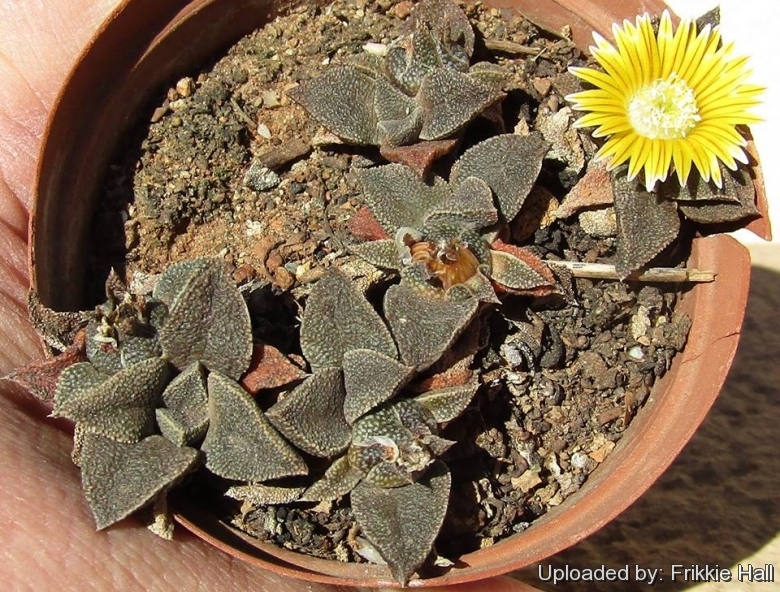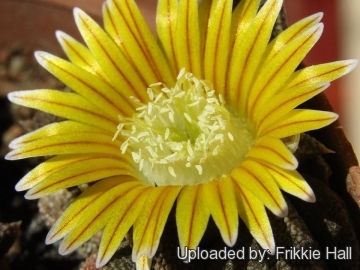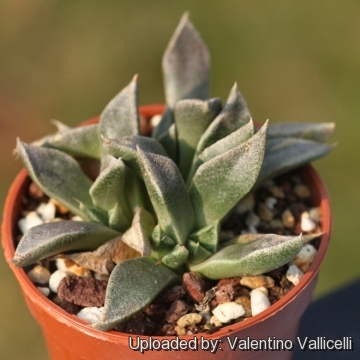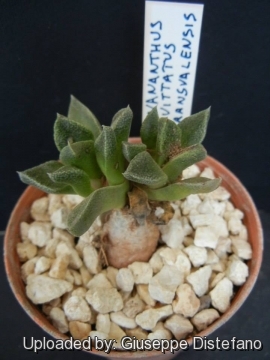= Nananthus transvaalensis (Rolfe) L. Bolus
Notes Mesembryanthemum [H.M.L. Bolus] 382-383, 1958 L. Bolus
Accepted Scientific Name: Nananthus vittatus (N.E.Br.) Schwantes
Gartenflora 1928, lxxvii. 68.

Aloinopsis transvaalensis (Nananthus transvaalensis) Photo by: Frikkie Hall
Origin and Habitat: Transvaal, South Africa.
Synonyms:
See all synonyms of Nananthus vittatus
back
Accepted name in llifle Database:Nananthus vittatus (N.E.Br.) SchwantesGartenflora 1928, lxxvii. 68.Synonymy: 18
back
Common Names include:
ENGLISH: Transvaal Iceplant.
CHINESE (中文): 纳南突斯
SPANISH (Español): Enanillo
Description: Nananthus transvaalensisSN|13440]]SN|13452]] is a rejected name used to describe a not specifically distinct populations of Nananthus vittatusSN|13440]]SN|13440]] with (perhaps) slightly larger leaves. The species name transvaalensis indicate the plants found in Transvaal, but they are in fact almost identical and not easily distinguishable from Nananthus vittatusSN|13440]]SN|13440]] to which this plant must be rightly placed. In the past identification of the genus Nananthus and especially Nananthus vittatusSN|13452]]SN|13440]] was problematic. In fact the plants in habitat show different growth phases and their appearance can change dramatically throughout the year and under different growing conditions. Such variations has led to establishment of several unnecessary names for this species.
Habit: It is a low, multi-branching, wrinkled, plant forming a mat with succulent leaves arranged in low rosettes and carrot like roots, will eventually form large caudex in time. It is very cold hardy.
Stem: Stemless.
Roots: Tuberous, gorgeous, fleshy up to 18 cm long.
Leaves: In 6-8 pairs, 20-30 mm long, 6-9 mm wide, 3-4 mm thick. They are opposite but of different lengths, spreading diagonally at most (Often erected under dry conditions) generally dark-green or dark olive-green, soft, ovate, lanceolate, sharpened on the top, keeled, the upper surface is slightly convex especially near the points, The adaxial and abaxial surfaces are rough and textured with fine warts (idioblasts) prominent in the upper leafs surface, sometime with a central channel.
Flowers: 2-2,5 cm in diameter, daisy-like flowers, yellow with a red stripe down each petal.
Blooming season: Winter.
Fruits: Capsules up to 8 mm tall and 8-11 mm wide (valve wings approx 2-3 times as broad as the expanding keels).
Seeds: 1,4-1,9 mm long, 1,2-1,6 mm large.
Bibliography: Major references and further lectures
1) Heidrun E. K. Hartmann “Aizoaceae F – Z” Springer, 2002
2) James Cullen, Sabina G. Knees, H. Suzanne Cubey “The European Garden Flora Flowering Plants: A Manual for the Identification of Plants Cultivated in Europe, Both Out-of-Doors and Under Glass - Casuarinaceae to Aristolochiaceae” Cambridge University Press, 11/ago/2011
3) Hermann Jacobsen, Vera Higgins “Succulent Plants: Description, Cultivation and Uses of Succulent Plants, Other Than Cacti” Williams and Norgate, Limited, 1935
4) Jacobsen. “Handbook of succulent plants” 1960
5) H. Herre “The genera of the Mesembryanthemaceae” Tafelberg-Uitgewers Beperk, 1971
 Aloinopsis transvaalensis (Nananthus transvaalensis) Photo by: Frikkie Hall
Aloinopsis transvaalensis (Nananthus transvaalensis) Photo by: Frikkie Hall Aloinopsis transvaalensis (Nananthus transvaalensis) Photo by: Frikkie Hall
Aloinopsis transvaalensis (Nananthus transvaalensis) Photo by: Frikkie Hall Aloinopsis transvaalensis (Nananthus transvaalensis) Photo by: Valentino Vallicelli
Aloinopsis transvaalensis (Nananthus transvaalensis) Photo by: Valentino Vallicelli Aloinopsis transvaalensis (Nananthus transvaalensis) Photo by: Giuseppe Distefano
Aloinopsis transvaalensis (Nananthus transvaalensis) Photo by: Giuseppe Distefano Aloinopsis transvaalensis (Nananthus transvaalensis) Photo by: Giuseppe Distefano
Aloinopsis transvaalensis (Nananthus transvaalensis) Photo by: Giuseppe DistefanoSend a photo of this plant.The gallery now contains thousands of pictures, however it is possible to do even more. We are, of course, seeking photos of species not yet shown in the gallery but not only that, we are also looking for better pictures than those already present.
Read More... Cultivation and Propagation: Nananthus are easy and rewarding plants. They grow on winter rain areas and were heading for summer dormancy. Suggestions have been made to keep them cool, shaded and dry in summer. This species usually "wakes up" in mid-Fall. Water minimally in summer, only when the plant starts shrivelling. (but it is indeed a very adaptable species that can grow opportunistically in summer too if the water availability and growing condition are favourable). They need full sun or light shade on the other seasons.
Soil: Because of the tap root they need a highly gritty compost with much drainage.
Frost Tolerance: Nananthus will take a small amount of frost for a short time (it is reported to be hardy to at least -12° C). Keep cool in summer.
Comment: It has a gorgeous, thick root system and when it is potted up, the plant can be progressively raised over the ground so that some of the roots can be seen and is especially cultivated for their looks. Architecturally it is a real stunner. When the "caudex" shape of the raised roots is adequately in evidence this plant is incomparable. They also tend to grow more "heads" when they are raised.
Propagation: Cuttings or (rarely) seeds.
















